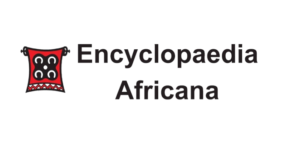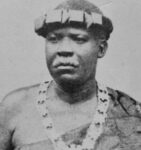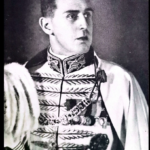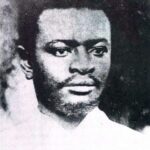KPANA LEWIS
- 5 Min Read
Kpana Lewis (18?-circa 1912) was the last Bai Sherbro or ruler of the Sherbro state. A leading member of the powerful Poro society, he defied the colonial administration over the imposition of a hut tax at the inauguration of the Protectorate by using the Poro to force a trade embargo. After the wars of resistance in 1898, in which he was thought to be heavily implicated, he was considered too dangerous to remain at liberty and ended his days in exile on the Gold Coast.

PHOTO CAPTION: Kpana Lewis. SOURCE: EA Library.
He was the grandson of the last title holder, Kong Kuba, who signed a treaty in 1825 with Governor Sir Charles Turner (term of office 1825-26) ceding Sherbro’s country to the British. Traditionally, the Bai, who resided at Yoni on Sherbro Island, was the ruler of all Sherbro, consisting of several mainland provinces.
But by the 19th century, central authority had weakened and many of the chiefs in the provinces had become virtually autonomous in their day-to-day affairs. Kana Lewis, who reigned from 1879-98, succeeded in asserting his claims of suzerainty over several chiefs, using the enormous political power of the Poro society, of which he was a leading member. He was also recognised by the colonial administration in Freetown which claimed, though it did not exercise jurisdiction over his territory. In 1881 he received a stipend as the direct successor to Kong Kuba. In 1896 the British government proclaimed a Protectorate over the area adjoining the Sierra Leone Colony. Ordinances to administer it were passed through the Legislative Council, including provision for a hut tax.
In protest, Kana Lewis and a deputation of chiefs went to Freetown to confront Governor Cardew early in 1897. After informing Kana that his territory was part of the colony and therefore unaffected by the Protectorate proclamation, Cardew told the delegation that they would have to obey the provisions of the Ordinance. Deeply dissatisfied, the chiefs returned to their homes.
On his return to Yoni, Kana Lewis took action by organising a boycott on trade with Krios (Creoles) and Europeans, enlisting the help of the Poro society, for whom restraint of trade was a customary form of political or economic control. It was reported that the Bai Sherbro had established a post at Kapala, in Sherbro district, “to prevent traders passing to and from, where natives are stopped from transacting business in general with the middlemen.” At this point, the administration decided on a show of force. In May 1897 a meeting of chiefs was called by T.J. Alldridge, district commissioner of the Sherbro, at which they were informed that severe punitive action would be taken against them if obstruction to trade continued.
The Sokong of Imperi replied that being under the orders of the Bai Sherbro he must first confer with him. But when it was learned that the Bai had issued further instructions to continue the boycott, the acting governor, Col. J.E. Caulfield; advised his detention. Two ordinances were passed, one making it a criminal offense to use the Poro or any similar institution to restrain trade, the other making it possible for the governor to detain Kana Lewis any time that he saw fit.
In January 1898, the Hut Tax War started in the north of Sierra Leone. In April it spread suddenly to the south, organised there, it was believed, by the Poro Society. As Kana was both a leading Poro chief, with suzerainty in some of the rebelling chiefdoms, as well as a known opponent of the Protectorate regime, District Commissioner Aldridge was convinced that he was the brain behind the resistance.
Although he disclaimed any knowledge, Kana was arrested by the governor on May 7, being treated as suspect, but against whom there seemed to be no evidence.” At the end of hostilities, still, without sufficient evidence to procure a conviction, he was deported to detention in Accra on July 30, 1899, along with Nyagua and Bai Bureh, also suspected ring leaders of the insurrection.
In Kpana’s case, the real reason seems to have been that trade importance is too great to risk any further trouble on the mainland.” It was further believed that his resistance to the Protectorate Ordinance arose from the fact that it made his provinces autonomous of the Sherbro state. On his banishment, Fama Yani, a former rival, was appointed paramount chief with limited jurisdiction over the Sherbro Island alone, which in effect ensured the autonomy of the paramount chiefs of the Sherbro mainland. Fama Yani could not even use the title Bai Sherbro, for under Sherbro customary law a ruler is made ruler for life and cannot be legally deposed. To legitimise the authority of a successor, the corpse of the deceased must be presented for much visual ceremony.
Although Bai Bureh was allowed back to Sierra Leone in 1905, the government remained adamant about Kana Lewis, even though the Anti-Slavery Society in London took up his case, and questions were asked about him in the British Parliament. In 1910, his son, Kong Kuba, petitioned for the return of his father.
But his petition was rejected outright, for Governor Sir Leslie Probyn (term of office 1904-11) was afraid that ‘’if Kana Lewis returns, the people will regard him as the head of a pagan tribal authority…due to the peculiarity of the tribal laws respecting succession and choice of chiefs…the return of Kana Lewis will enable his son Kong Kuba alias Herbert Lewis, to commence scheming for the overthrow of Fama Yani, the present Paramount Chief.”
Kana Lewis died in exile around 1912, and with his banishment, the Sherbro state lost its last ruler, its sovereignty, and its territorial integrity. The provinces all became autonomous chiefdoms under their paramount chiefs.
ARTHUR ABRAHAM and CHRISTOPHER FYFE





